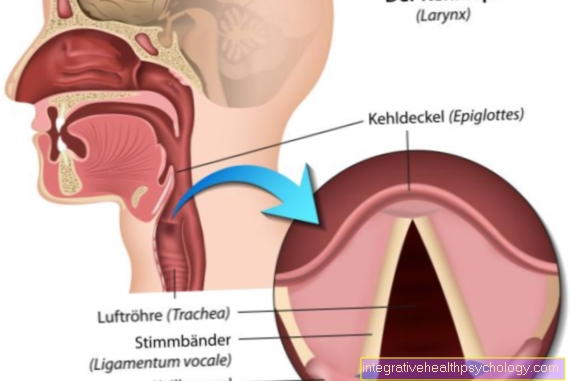Abscess on the forehead
definition
An abscess on the forehead is a cavity filled with pus that has formed due to an infection with bacteria.
The body encapsulates the boil with a thin membrane to prevent the infection from spreading to surrounding tissues.

causes
In principle, abscesses can form anywhere on the surface of the body or on all organs. There are often pus pimples on the forehead, which are already small abscesses. The usual pus pimples are a relatively harmless form of abscess that occurs when the fine pores of the facial skin become clogged with excess sebum and flakes of skin. The clogged pores are colonized by bacteria and lead to local inflammation with pus formation.
Abscesses are caused by germs such as bacteria or fungi that multiply on the skin. The main cause of the boils is in most cases the bacterium Staphylococcus aureus, a component of the natural human skin flora. The bacteria get into the tissue through small injuries to the skin and lead to an infection.
Pushing around and removing blemishes can cause small wounds on the forehead, which pathogens can penetrate and cause an abscess. The immune system tries to fight the bacteria, but fails and therefore encapsulates the inflammation from the rest of the tissue with a thin membrane. People with weak immune systems, such as those who have cancer and who are taking immunosuppressive drugs, are particularly prone to abscesses. An unhealthy diet and hormonal fluctuations favor the development of skin blemishes, from which abscesses can form.
Even if the skin barrier is no longer intact, as is the case, for example, in people with neurodermatitis or allergies, the bacteria can easily penetrate deep under the skin and cause abscesses.
Also read our articles:
- Causes of an Abscess
- Abscess or boil
diagnosis
The diagnosis of an abscess on the forehead is made relatively clearly via the typical skin changes. The doctor can also take a smear of the purulent secretion and thereby determine the exact pathogen.
If the patient has a fever or if the inflammation has spread, blood can be drawn and the inflammation values analyzed.
Symptoms
An abscess on the forehead is a visible collection of pus that is separated from the rest of the tissue by a capsule.
When the abscess has matured under the skin, a yellowish-white pus head is visible in the center. When touched, the abscess can open spontaneously and the pus drains. The tissue around the abscess is very red and swollen. An abscess can cause throbbing pain. The skin around the inflammation feels warm and is very sensitive to the touch.
If the inflammation spreads to the surrounding tissue, other symptoms such as fever, body aches and a general feeling of illness can occur. A large abscess on the forehead is particularly dangerous because the brain is in close proximity to the inflammation focus and can easily be attacked by the pathogens. The result is a life-threatening abscess in the brain. Then headaches, dizziness and clouding of consciousness also occur.
Read more about the topic here: Abscess in the brain
a headache
If you have an additional headache with an abscess on your forehead, you should see a doctor immediately.
There is a risk here that the bacteria from the accumulation of pus have spread through the surrounding tissue and into the bloodstream. Get through the venous blood flow and have triggered a so-called sinus vein thrombosis, which is life-threatening.
The possibility of a brain abscess must also be ruled out. Abscesses in the brain are often associated with headaches, decreased consciousness, nausea, and vomiting.
At this point, the editors recommend the following article: Abscess on the head
treatment
Small abscesses don't require treatment and usually heal on their own within a few days.
If you have a large abscess on your forehead, you should definitely see a doctor who will treat the boil properly. The abscess must not be squeezed out by yourself, otherwise serious complications can arise. The abscess needs to mature, which means that the pus collects on the surface of the skin and is visible as a yellow head. Immature abscesses can, after consultation with a doctor, be treated with so-called pull ointments, which help the boil to mature faster and allow the pus to drain away.
Read more on the topic: Treatment of an abscess
The pulling ointment also has an anti-inflammatory effect and promotes rapid healing. In some cases, treatment with a pulling ointment also causes the abscess to spontaneously open and empty on its own. In order to promote the healing process, the doctor prescribes an antibiotic that must be taken for several days.
Also read: Treating an abscess with ointment
Usually, an abscess is split open by a doctor as part of a minor surgical procedure. In the facial area, however, the abscess cannot be split, as there is a great risk that the bacteria will be carried away. The blood from the face area flows into the inside of the skull through small veins. In this way, the pathogens can also reach the brain and cause meningitis or an abscess there. Therefore, conservative treatment with ointments and creams is recommended for the treatment of abscesses on the forehead.
Read more on the topic:
- Home remedies for an abscess
- Betaisodona spray
Should you express the abscess yourself?
An abscess on the forehead must under no circumstances be self-expressed. By pushing around, the bacteria and pus are squeezed deeper into the tissue, which can lead to life-threatening complications. If the germs get into the bloodstream or lymph vessels, they can quickly spread throughout the body and cause blood poisoning (sepsis).
Pressing around on the forehead can cause particularly great damage, as there is a risk that the bacteria can quickly get into the brain and lead to inflammation and abscesses there.
Duration
The duration of an abscess on the forehead depends largely on the size of the inflammation.
Small pus pimples mature within a day or two and then heal quickly on their own. For larger abscesses, see a doctor who will cut open the bump and allow the pus to drain away. The cut in the skin usually heals on its own after a few days.
Read more on the topic: Healing an abscess





























